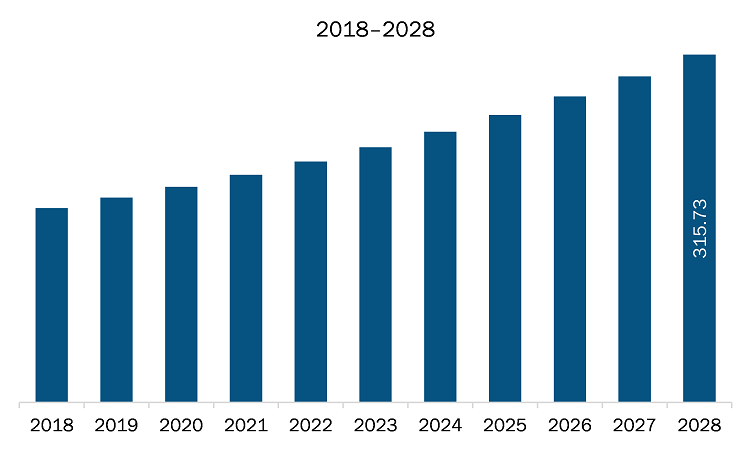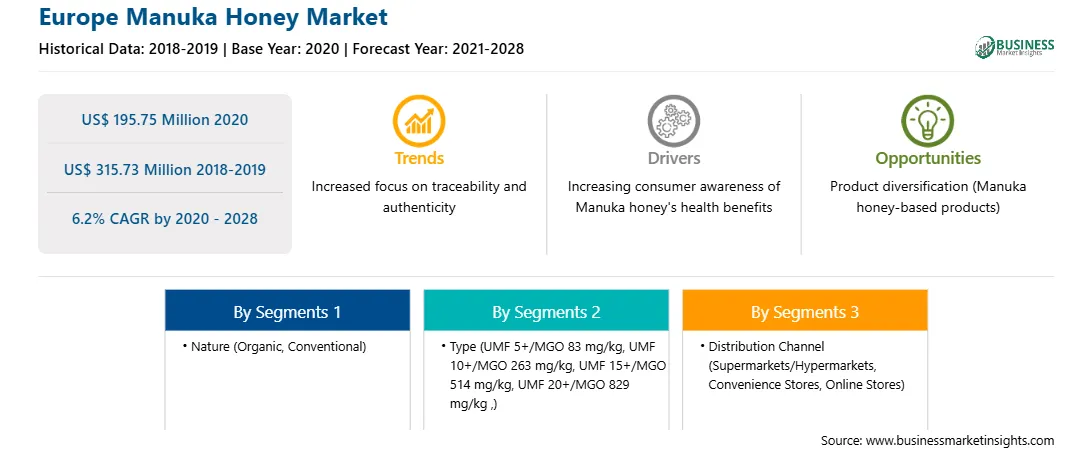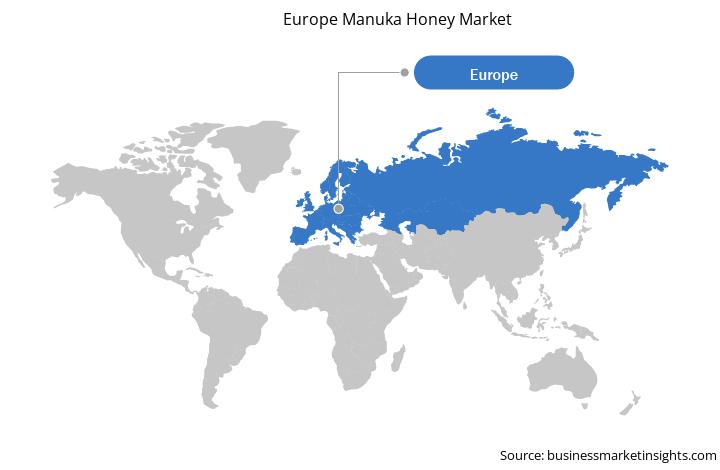European continent comprises several developed economies, such as Germany, France, UK, and Italy. The market for manuka honey in Europe is witnessing growth owing to the presence of well-established players such as Comvita, Manuka Health, Oha Honey, and Capilano Honey Ltd in the region. With increasing health consciousness among the consumers, the demand for manuka honey in the region is expected to grow during the forecast period. Alongside honey production, exports have also grown in recent years, with Germany, the UK, France, Spain, and Italy being the main markets in Europe.The popularity of manuka honey has increased within the region. Moreover, the higher purchasing power of the consumers and the rising preference for nutritional products has propelled the demand for manuka honey in Europe. The consumption of honey per capita per year is highest in countries of central Europe, such as Germany, Austria, and Switzerland, where annual consumption per capita exceeds one kilogram. Manuka honey have been gaining popularity in the European regions due to the increasing demand for the nutritional rich food. The surge in the demand for high quality New Zealand Honey sourced from wild manuka plants increase the consumption of manuka honey in Europe. With the rising individual income, the consumers in Europe are focusing on buying manuka honey that satiate the consumer nutritional needs.
In Europe, currently the France, Russia UK and Italy are the hardest-hit countries by the coronavirus pandemic. It is estimated to suffer an economic hit due to a lack of revenue from various industries, as the country recorded the highest number of coronavirus cases followed by France, Spain, Russia, and Germany. Other member states have implemented drastic measures and travel restrictions, including partially closing their borders. This is anticipated to impact market growth in Europe. The ongoing pandemic has drastically altered the status of the manuka honey industry and has negatively impacted the growth of the market. The COVID-19 outbreak has distorted operational efficiency and disrupted the value chains due to the sudden closure of national and international boundaries, creating revenue loss and damage. The disruptive value chain has had a negative impact on raw material supply, which, in turn, is impacting the growth of the manuka honey market. However, as the economies are planning to revive their operations, the demand for manuka honey is expected to rise globally. Although the focus over just-in-time production is another concerning factor hindering market growth. With the growing consciousness towards health amongst consumers and diversification of application bases in post-pandemic times, the demand for manuka honey is expected to take huge leaps.

Strategic insights for the Europe Manuka Honey provides data-driven analysis of the industry landscape, including current trends, key players, and regional nuances. These insights offer actionable recommendations, enabling readers to differentiate themselves from competitors by identifying untapped segments or developing unique value propositions. Leveraging data analytics, these insights help industry players anticipate the market shifts, whether investors, manufacturers, or other stakeholders. A future-oriented perspective is essential, helping stakeholders anticipate market shifts and position themselves for long-term success in this dynamic region. Ultimately, effective strategic insights empower readers to make informed decisions that drive profitability and achieve their business objectives within the market.

| Report Attribute | Details |
|---|---|
| Market size in 2020 | US$ 195.75 Million |
| Market Size by 2028 | US$ 315.73 Million |
| Global CAGR (2020 - 2028) | 6.2% |
| Historical Data | 2018-2019 |
| Forecast period | 2021-2028 |
| Segments Covered |
By Nature
|
| Regions and Countries Covered | Europe
|
| Market leaders and key company profiles |
The geographic scope of the Europe Manuka Honey refers to the specific areas in which a business operates and competes. Understanding local distinctions, such as diverse consumer preferences (e.g., demand for specific plug types or battery backup durations), varying economic conditions, and regulatory environments, is crucial for tailoring strategies to specific markets. Businesses can expand their reach by identifying underserved areas or adapting their offerings to meet local demands. A clear market focus allows for more effective resource allocation, targeted marketing campaigns, and better positioning against local competitors, ultimately driving growth in those targeted areas.

The manuka honey market in Europe is expected to grow US$ 315.73 million by 2028 from US$ 195.75 million in 2020. The market is estimated to grow at a CAGR of 6.2% from 2020 to 2028. The rise in disposable income and the need to enhance physical appearance among consumers propel the demand for self-grooming products. The improvement in quality of life, the positive effects of personal care on self-esteem and social interaction, and the gradual consumer shift toward luxury and premium self-grooming products are a few factors that are expected to drive the market growth during the forecast period. Manuka honey, sourced from the manuka plant in Australia and New Zealand, goes beyond the regular table honey. Its anti-inflammatory and antibacterial properties make it best suitable ingredient for several skin-related products. Manuka’s properties are best used in treating acne and as an effective moisturizer. Further, manuka is full of active ingredients and methylglyoxal that makes it potent. Consumers are becoming label-conscious and seeking products made from natural ingredients. Clean label cosmetic products made from plant extracts without synthetic ingredients are gaining considerable traction in the market. Thus, personal care & beauty product manufacturers are using manuka honey in cosmetic formulations. As per the World Health Organization (WHO), by 2050, the world’s geriatric population (60 years and above) will reach up to 2 billion, up from 900 million in 2015. Thus, the demand for anti-aging or anti-wrinkle creams is set to increase in the coming years. These cosmetics are also formulated using extracts of botanicals such as manuka honey, orange, and tea. Therefore, factors such as the rapidly aging population, the increasing introduction of natural cosmetics, and penetration of online retail networks are expected to benefit the growth of the manuka honey market in the coming years.
Europe manuka honey market is segmented based on nature, type, and distribution channel Based on nature, the Europe manuka honey market based on nature is segmented into organic and conventional. The conventional segment accounted for the highest share in the market in 2019 and organic segment is expected to be fastest growing during forecast period. Based on type, is segmented into UMF 5+/MGO 83 mg/kg (ppm), UMF 10+/MGO 263 mg/kg (ppm), UMF 15+/MGO 514 mg/kg (ppm), and UMF 20+/MGO 829 mg/kg (ppm). The UMF 15+/MGO 514 mg/kg (ppm) segment accounted for the highest share in 2020 and UMF 20+/MGO 829 mg/kg (ppm) segment is expected to be the fastest growing during forecast period. Based on distribution channel, the market is segmented into supermarkets/hypermarkets, convenience stores, online stores and others. The supermarket/hypermarket segment accounted for the highest share in 2019 and online store segment is expected to be the fastest growing during forecast period.
A few major primary and secondary sources referred to for preparing this report on manuka honey market in Europe are company websites, annual reports, financial reports, national government documents, and statistical database, among others. Major companies listed in the report are 100% Pure New Zealand Honey; Arataki Honey; Comvita; Manuka Health; Oha Honey; Midlands Holdings; Capilano Honey Ltd; Streamland; and Wedderspoon Organic.
The Europe Manuka Honey Market is valued at US$ 195.75 Million in 2020, it is projected to reach US$ 315.73 Million by 2028.
As per our report Europe Manuka Honey Market, the market size is valued at US$ 195.75 Million in 2020, projecting it to reach US$ 315.73 Million by 2028. This translates to a CAGR of approximately 6.2% during the forecast period.
The Europe Manuka Honey Market report typically cover these key segments-
The historic period, base year, and forecast period can vary slightly depending on the specific market research report. However, for the Europe Manuka Honey Market report:
The Europe Manuka Honey Market is populated by several key players, each contributing to its growth and innovation. Some of the major players include:
The Europe Manuka Honey Market report is valuable for diverse stakeholders, including:
Essentially, anyone involved in or considering involvement in the Europe Manuka Honey Market value chain can benefit from the information contained in a comprehensive market report.